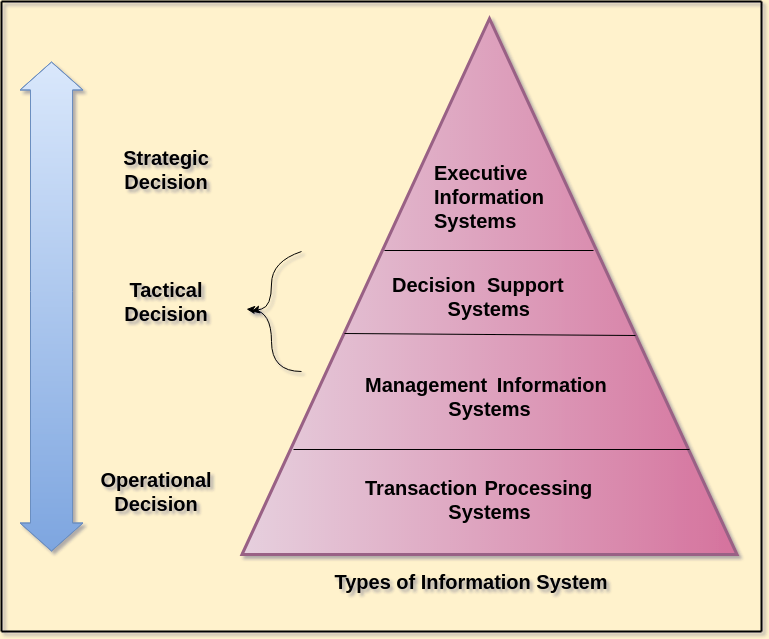Introduction to Information SystemAn information system can be defined as a set of interrelated components that collect, manipulate, store data, distribute information to support decision making and provide a feedback mechanism to monitor performance. It may also help the manager and workers to analyse problems, visualize complex subject, and create new products. Software, Hardware, information system users, computer system connections and information, and the system's housing are all part of an Information System. Components of Information SystemThe components that must be combined together in order to produce an information system are: People: Peoples are the most essential part of the information system because without them the system cannot be operated correctly. Hardware: It is the part of a physical component of an information system which we can touch. The information system hardware includes the computer, processors, monitors, printer, keyboards, disk drives, iPads, flash drives, etc. Software: It is a set of instruction that tells the hardware what to do. It can be used to organize, process and analyse data in the information system. Data: Data is a collection of facts. Information systems work with data. These data can be aggregated, indexed, and organized into tables and files together to form a database. These databases can become a powerful tool for every businesses information system. Network: It includes internet, intranet, extranet to provide successful operations for all types of organizations and computer-based information system. Procedures: It specifies the policies that govern the operation of an information system. It describes how specific method of data are processed and analysed to get the answers for which the information system is designed. Feedback: It is the component of an information system which defines that an IS may be provided with feedback. Types of Information systemThe information systems can be categorized into four types. These are: 
1. Executive Information SystemsIt is a strategic-level information system which is found at the top of the Pyramid. Its primary goal is to provide information gathered from both internal and external sources to the senior executives and management to analyse the environment in which the organization operates, and to plan appropriate courses of action for identifying the long-term trends. It can also be used to monitor organization performance as well as to identify opportunities and problems. EIS is designed in such a way that it can be operated directly by executives without the need for intermediaries. The role of Executive Information Systems are:
2. Decision Support SystemsA DSS or Decision Support System is a computer application program used by senior managers to analyse the business data and presents it in that form in which the users can make business decisions more easily. These systems are usually interactive and can be used to solve ill-structured problems in an organization. It helps in exchanging the information within the organization. The role of Decision Support System are:
3. Management Information SystemsMIS or Management Information System is the use of information technology, people, and business processes to record, store, manipulate, and process data to produce meaningful information. These information helps decision makers to make day to day decisions correctly and accurately. It is used to make a tactical decision (middle-term decision) to ensure the smooth running of an organization. It also helps to evaluate the organization's performance by comparing previous outputs with current output. The role of Management Information Systems are:
4. Transaction Processing SystemsTPS or transaction processing system is a type of information processing system for business transactions that involve the collection, storage, modification and retrieval of all data transaction of an enterprise. The characteristics of a Transaction Processing System includes reliability, performance, and consistency. A TPS is also known as real-time processing. The role of Transaction Processing System are:
Development of Information SystemAn Information System Development is a set of activities, methods, best practices, deliverables and automated tools that every organization use to develop and continuously improve information systems and its related software. There are four steps which can be used to develop an information system. These are: 1. Define and understand the problems The purpose of the first step is to find the scope of the problem and determine solutions. This phase also includes and considered resources, time, cost, and other items for the requirements of the information system. 2. Develop an alternative solution The purpose of this steps is to find a path to the solution determined by system analysis. In this phase some solution require modification in the existing system, some solution does not require an information system, and some solution requires a new system. 3. Evaluate and choose the best solution The purpose of the third step is to evaluate the feasibility issues related to financial, technical, and organizational. It measures the time and cost to design an information system. It evaluates the business value of a system and finds the best solution for developing an information system. 4. Implement the solution The purpose of the last step is to create the detailed design specification for an information system. This phase provides complete implementations for-
Next TopicCyber Security Tutorial
|
 For Videos Join Our Youtube Channel: Join Now
For Videos Join Our Youtube Channel: Join Now
Feedback
- Send your Feedback to [email protected]
Help Others, Please Share










